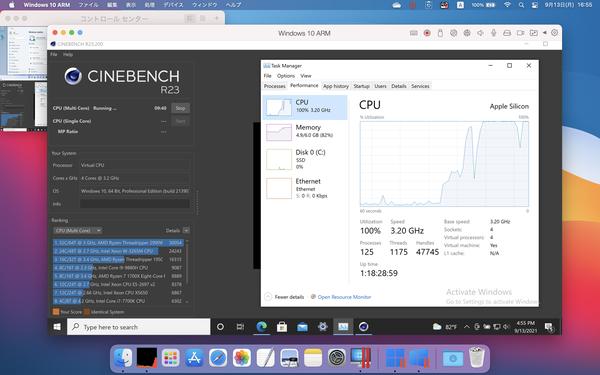ASCII.jp M1 Check the performance of "Parallels Desktop 17" running Windows on Mac with a benchmark test
On the Mac, the latest version 17 of Parallels Desktop, software that allows you to use various operating systems, including Windows, and applications that run on them, has appeared. Last time, as mentioned in "Review of "Parallels Desktop 17" where Windows 11 IP version runs on M1 Mac", it is possible to use up to ARM versions of Windows 10 and Windows 11 on M1-equipped Macs even though it is an Insider Preview version. This time, we will deliver a review on the performance side that is worrisome.
Performance Improvement Areas Quantified by Parallels
The performance of a virtual machine varies greatly depending on various conditions related to the operating environment, so it is difficult to evaluate it by a general numerical value. Not to mention Macs, the CPUs of recent personal computers almost without exception have a multi-core configuration. In software that runs virtual machines such as Parallels, how many of those CPU cores are allocated to the virtual machine, and how much memory the virtual machine can use from the memory implemented by the actual machine. etc., can be set. The number of CPU cores and memory capacity have a considerable impact on the performance of the virtual machine.
And even with all these conditions, all input and output functions, including screen display and networking, are dependent on the host machine, so it's working in a rented state, so you can always demonstrate stable performance. Not necessarily.
Nevertheless, looking at the announcement materials of the new version, Parallels puts out concrete figures and declares performance improvements. I haven't re-evaluated and verified each number here, but it should serve as a reference for the maximum performance improvement when various conditions are optimized. You won't always benefit from these performance improvements for the reasons I listed above, but let's take a look at those numbers.

First of all, the following three general performance improvements are listed regardless of the type of CPU of the Mac.
・Windows and Linux resume up to 38% faster ・OpenGL performance up to 6x faster ・2D graphics up to 25% faster
Resume in this case is an operation to return to the original state after recording (suspending) the state of the virtual machine, including the contents of memory and disk, and many users frequently use it. right. Since it has nothing to do with the type of apps used on the virtual machine, it can be said that it is a practically effective performance improvement for all users. For this, I actually measured the time it takes to boot and shut down Windows on a virtual machine, suspend a running Windows and then resume it. It is not a comparison with the previous version, but a confirmation of the current Parallels performance, which will be summarized later. I haven't checked the performance of OpenGL or 2D graphics.
Next, regarding the performance improvement limited to Macs equipped with the M1 chip, the following three points are mentioned.
・Windows 10 Insider Preview starts up to 33% faster ・Windows 10 Insider Preview disk performance is up to 20% faster ・DirectX 11 performance is up to 28% faster
In the case of M1-equipped Macs, there is currently no choice but to use the ARM version of Insider Preview provided by Microsoft as Windows. Therefore, this result is also considered to be provisional, but even if the product version of Windows for ARM appears, it is unlikely that the contents will change so much, so this performance improvement will be inherited almost as it is. Seem. These are encouraging numbers. As mentioned above, we are actually measuring the current Windows startup time, so we will show it later.
Furthermore, for Macs with Intel CPUs, the following points are mentioned.
・Up to 60% faster network performance for virtual machines on macOS Big Sur or later
This is when using macOS as a guest OS on an Intel-powered Mac virtual machine. Moreover, since the version is Big Sur or later, the number of users who actually benefit will be limited. Still, any improvement in network performance should be welcome.